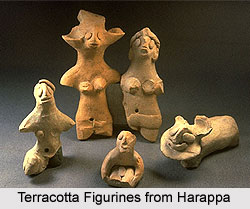 Art and craft of Indus Valley Civilisation touched the peak of excellence in its contemporary times. The Indus Valley civilization is one of the initial urban civilizations in the world, along with its contemporaries, Mesopotamia and Ancient Egypt. The people of this ancient Indus river valley developed new techniques in handicraft. Chronologically, the Harappan civilization is catagorised into three phases:
Art and craft of Indus Valley Civilisation touched the peak of excellence in its contemporary times. The Indus Valley civilization is one of the initial urban civilizations in the world, along with its contemporaries, Mesopotamia and Ancient Egypt. The people of this ancient Indus river valley developed new techniques in handicraft. Chronologically, the Harappan civilization is catagorised into three phases:
(i) Early Harappan phase (3500 BC-2600 BC) - It was draws the town-planning in the form of mud structures, elementary trade, arts and crafts, etc.,
(ii) Mature Harappan phase (2600 BC-1900 BC) - It depicts the well developed towns with the burnt brick structures, inland and foreign trade, crafts of various types, etc.
(iii) Late Harappan phase (1900 BC-1400 BC) - The late phase of decline during which many cities were abandoned and the and the gradual decay of the urbanization.
Use Of Gold in Harappan Civilisation
The Harappan people were well aware of almost all the metals except iron. They manufactured the elements made up of silver and gold. The gold materials like beads, armlets, needles and other ornaments. But the usage of silver was more common than gold. A large number of silver ornaments, dishes, etc. have been discovered. A number of copper tools and weapons have also been discovered. The common tools included axe, saws, chisels, knives, spearheads and arrowheads. It is very important to note that the arms and the ammunitions produced by the Harappans. They were mostly defensive in nature as there is no evidence of weapons like swords, spears and arrows etc. Stone tools were also commonly used among the Harappans. The copper was brought mainly from Khetri in Rajasthan.
 Scriptures Of Harappa in Harappan Civilisation
Scriptures Of Harappa in Harappan Civilisation
There a famous piece of art in the Harappan period is a stone sculpture of a bearded man discovered at Mohenjodaro. His eyes are half closed indicating a posture of meditation. It shows that the religious maniac is common in that time. There across the left shoulder is an embroidered cloak. In the opinion of some scholars it could be a bust of a priest. There are the large numbers of terracotta figurines of males and females have been discovered from various Harappan sites. The female figurines outnumber those of males and are affirmed to represent the worship of Mother Goddess. Besides these, a wide variety of clay and porcelain models of birds, monkeys, dogs, sheep, cattle, humped and hump less bulls are found. However, the noteworthy specimens in this regard are various models of terracotta carts. Out of these, the people of Harappan civilization are also well accustomed with the idols and the utensils made up of clay. Pottery-making was also an important industry in the Harappan period. These were chiefly wheel-made and were treated with a red coating. It is very interesting to see that all the decorations were in black. These are found in different sizes and shapes. The painted designs consist of horizontal lines of varied thickness, leaf patterns, palm and pipal trees. The idols of birds, fishes and animals are also depicted on potteries.
Craftmanship In Harappan Cult
The Harappans manufactured seals of various kinds. It is said that more than two thousand seals have been discovered from different sites of the twin cities-Harappa and Mohenjo-Daro. These noteworthy scriptures were generally square in shape and made of steatite. The seals depict a number of animals and there is no representation of horse on these. It is proved that the there was non availability of horses in the Harappan times. It has led many scholars to argue that horse was not known to the Harappan people though there are others who do not accept this argument. The archaeologists also discovered the Harappan seals contain some signs in the Harappan script which however has not been deciphered so far. The most famous of the seals is the one with a horned male deity represented on it. He has three heads and is sitting in a yogic posture surrounded by four animals like elephant, tiger, rhinoceros and a buffalo. It was identified by many historians with the ancient form of the God Pashupati that is the Lord of Beasts. Dicing was the favourite game at that time. Beside this, the hunting of wild animals, bull fight, fishing, and also the clay modelling were the general amusements of the people of that time. The making of toys was also done at that time. According to the scholars, the craftsmen taught their skills in crafting to their children. The toys were used by the children of the family. It shows that the occupation at that time was mostly hierarchical.



















